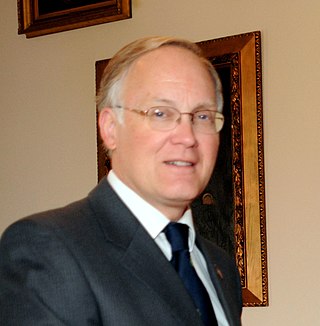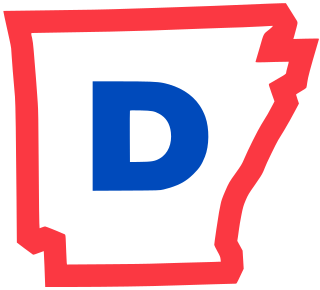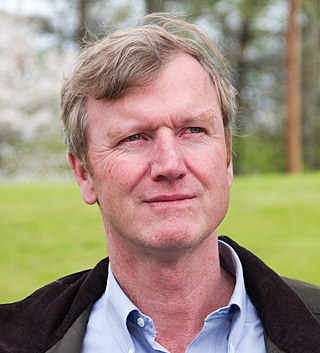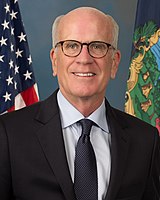
James Holley Douglas is an American politician from the state of Vermont. A Republican, he served as the 80th governor of Vermont from 2003 to 2011. On August 27, 2009, Douglas announced that he would not seek re-election for a fifth term in 2010. He left the office in January 2011.

The Kansas Republican Party is the state affiliate political party in Kansas of the United States Republican Party. The Kansas Republican Party was organized in May 1859.

The Democratic Party of Illinois is the affiliate of the Democratic Party in the U.S. state of Illinois. It is the oldest extant state party in Illinois and one of just two recognized parties in the state, along with the Republican Party. It is currently the dominant party in the state, controlling the majority of Illinois' U.S. House seats, both U.S. Senate seats, both houses of the state legislature, and the governorship.

Peter Francis Welch is an American lawyer and politician serving since 2023 as the junior United States senator from Vermont. A member of the Democratic Party, he was the U.S. representative for Vermont's at-large congressional district from 2007 to 2023. He has been a major figure in Vermont politics for over four decades, and is only the second Democrat to be elected a senator from the state.
The Pennsylvania Republican Party (PAGOP) is the state affiliate of the Republican Party in Pennsylvania. It is headquartered in Harrisburg. Its chair is Lawrence Tabas and is the second largest political party in the state behind the Pennsylvania Democratic Party.

The Democratic Party of Arkansas is the affiliate of the Democratic Party in the state of Arkansas. The current party chair is Grant Tennille. Former U.S. president Bill Clinton was born in Arkansas, and served as state governor from 1979 to 1981 and 1983 to 1992.
The Delaware Democratic Party (DelDems) is the affiliate of the Democratic Party in the U.S. state of Delaware. It is headquartered in New Castle County and chaired by Erik Raser-Schramm.

The New York State Democratic Party is the affiliate of the Democratic Party in the U.S. state of New York. Its headquarters are in Manhattan, and it has an office in Albany.
The politics of Vermont encompass the acts of the elected legislative bodies of the US state, the actions of its governors, as overseen by the Vermont courts, and the acts of the political parties that vie for elective power within the state. The state's politics include local Democratic and Republican political parties, as well as several smaller parties.
The Vermont Republican Party is the affiliate of the Republican Party in Vermont and has been active since its foundation in the 1860s. The party is the second largest in the state behind the Vermont Democratic Party, but ahead of the Vermont Progressive Party. The party historically dominated Vermont politics until the mid-20th century, but was replaced by the Vermont Democratic Party. The party currently has very weak federal electoral power in the state, controlling none of Vermont's federal elected offices. The only statewide office that the party currently controls is the governorship, held by Phil Scott.
Illinois is a Democratic stronghold in presidential elections and one of the "Big Three" Democratic strongholds alongside California and New York. It is one of the most Democratic states in the nation with all state executive offices and both state legislative branches held by Democrats. For most of its history, Illinois was widely considered to be a swing state, voting for the winner of all but two presidential elections in the 20th century. Political party strength in Illinois is highly dependent upon Cook County, and the state's reputation as a blue state rests upon the fact that over 40% of its population and political power is concentrated in Chicago, Cook County, and the Chicago metropolitan area. Outside of Chicago, the suburban collar counties continue trending Democratic while downstate Illinois can be considered more conservative with several Democratic leaning regions including Champaign-Urbana, Bloomington-Normal, Rockford, Peoria, the Quad Cities, and suburban St. Louis.

Elections in Vermont are authorized under Chapter II of the Vermont State Constitution, articles 43–49, which establishes elections for the state level officers, cabinet, and legislature. Articles 50–53 establish the election of county-level officers.

The Government of Mississippi is the government of the U.S. state of Mississippi. Power in Mississippi's government is distributed by the state's Constitution between the executive and legislative branches. The state's current governor is Tate Reeves. The Mississippi Legislature consists of the House of Representatives and Senate. Mississippi is one of only five states that elects its state officials in odd numbered years. Mississippi holds elections for these offices every four years in the years preceding Presidential election years.

The 1990 Vermont gubernatorial election took place on November 6, 1990. Incumbent Democratic Governor Madeleine Kunin did not seek re-election. Former Governor Republican Richard Snelling defeated Democratic former State Senate President pro tempore Peter Welch in the general election. This would be the last Republican victory in a Vermont gubernatorial election until 2002.
The State government of Arkansas is divided into three branches: executive, legislative and judicial. These consist of the state governor's office, a bicameral state legislature known as the Arkansas General Assembly, and a state court system. The Arkansas Constitution delineates the structure and function of the state government. Since 1963, Arkansas has had four seats in the U.S. House of Representatives. Like all other states, it has two seats in the U.S. Senate.

Scott Edward Milne is an American businessman and political candidate from North Pomfret, Vermont. A Republican, Milne was the party's nominee for Lieutenant Governor of Vermont in 2020, losing to Democrat Molly Gray; the nominee for United States Senate in 2016, losing to incumbent Democrat Patrick Leahy; and the nominee for Governor of Vermont in 2014, losing to two-term incumbent Peter Shumlin in the closest gubernatorial election in Vermont since 1962.

The 1988 United States House of Representatives election in Vermont was held on November 8, 1988. Republican nominee Peter Plympton Smith defeated Independent candidate Bernie Sanders and Democratic nominee Paul N. Poirier.

The 2022 United States Senate election in Vermont was held on November 8, 2022, to elect a member of the United States Senate to represent the state of Vermont. It was held concurrently with U.S. Senate elections in other states, along with elections to the United States House of Representatives and various state and local elections across the country. The incumbent senator, Democrat Patrick Leahy, announced on November 15, 2021, that he would not seek re-election to a ninth term, leaving the seat open for the first time since 1974.

A general election was held in the U.S. state of Vermont on November 3, 2020. All of Vermont's executive officers were up for election, as well as Vermont's at-large seat in the United States House of Representatives. Primary elections were held on August 11, 2020.

The 2022 Vermont Senate election took place on November 8, 2022, as part of the biennial United States elections. The election coincided with elections for other offices including the U.S. Senate, U.S. House, Governor, and State House. Vermont voters elected all 30 state senators from 16 districts, with each district electing between one and three senators. State senators serve two-year terms in the Vermont Senate. Primary elections were held on August 9, 2022. This election would be the first to use new districts adopted by the Vermont General Assembly to allocate for population changes across the state after the 2020 census.
















